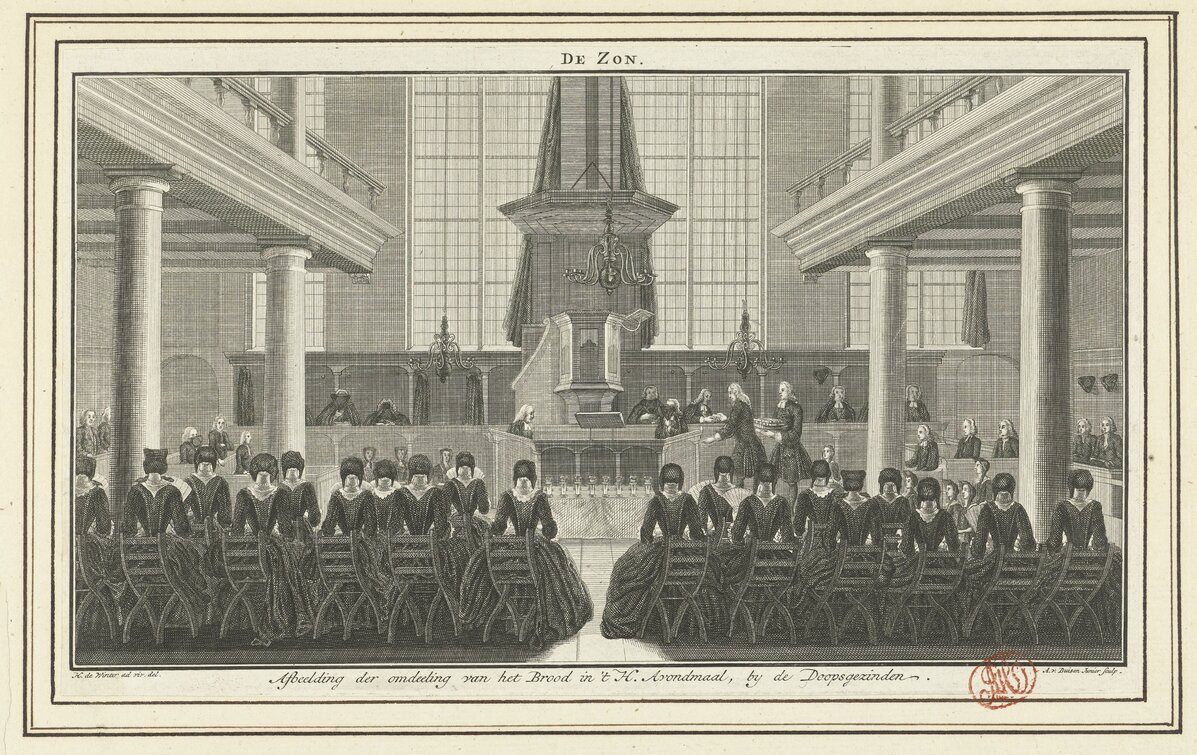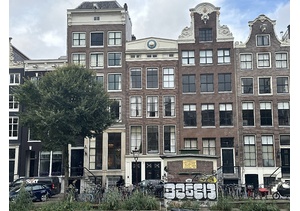The so-called War of the Lambs was a heated conflict that led to a schism among the Dutch Mennonites and Doopsgezinden in 1664. This illustration from an early Mennonite history book depicts worship inside the gathering place from which the orthodox Zonist faction got their name.
Location
De Zon
Singel 118
Type
Hidden church
Religious community
Mennonite Church
Object
Print depicting the sharing of the bread during a communion service in De Zon
Maker and date
Andries van Buysen
1743
Visit
The print is not on display
The War of the Lambs and a Zonist Mennonite’s Hopes for Reunification
Disagreement about the nature and role of confessions of faith resulted in a heated intra-Mennonite conflict known as the “War of the Lambs.” One group, inspired by Collegiant and Mennonite minister Galenus Abrahamsz. de Haan, preferred to understand confessions as flexible, context-bound documents. The stricter faction viewed them as binding expressions of belief. At the Kerk bij ’t Lam (Church by the Lamb) in Amsterdam, the matter became so heated that the city magistrates had to arbitrate.
On June 22 1664, a formal split occurred. The orthodox group – about 500 of the 2,000 members – started gathering at a warehouse in the Oude Teertuinen, and then purchased a two-story former-brewery on the Singel. Because of the sun on its gable, the church was called De Zon (The Sun) and congregants became known as the Zonists. Those who remained at the Kerk bij ’t Lam were called Lamists. Mennonite congregations around the Republic followed suit, affiliating with either the Lamists or Zonists according to their own positions within this debate.
The print of a gathering for the Lord’s Supper in De Zon was one of several depictions of Mennonite worship practices made by De Zon member Hendrik de Winter for a new extended version of Hermannus Schijn’s book on the history of the Mennonites. Schijn, who was a physician, writer, and minister, was a staunch Zonist and served as an elder at De Zon from 1690 until his death in 1727. However, he also longed to see the unification of the fractious Mennonite movement. In 1723, for instance, he published his Project for the Unification of the Mennonite Christians.
Gradually, differences between Lamists and Zonists became less prominent, congregation numbers decreased, and concerns about financial matters (among others, large loans to the House of Orange likely to be left unpaid in the wake of the Batavian Revolution) made reunification the logical choice. Though Schijn did not live to see it, the Lamists and Zonists of Amsterdam reunited in 1801 and, at a national level, nearly all of the Mennonite groups united into the Algemene Doopsgezinde Sociëteit in 1811.
Dutch Mennonite/Doopsgezind subgroups
There were many different branches of Dutch Mennonites in the early modern period, including Old and Young Flemish, Old and Young Frisians, High Germans, Waterlanders, and other splinter groups. Mergers also occurred (eg., the Flemish, Frisians, High Germans, and later also Waterlanders, united with the Flemish at the Kerk bij ’t Lam). As of the 1660s, groups also redivided themselves as Lamists or Zonists (see Lammerenkrijgh). Nearly all groups reunited in Amsterdam in 1801, and nationally in 1811, forming the Algemene Doopsgezinde Sociëteit (ADS).
Lammerenkrijgh [War of the Lambs]
A conflict regarding confessions of faith led to a schism in the Kerk bij’t Lam in 1664. The minister and Collegiant thinker Galenus Abrahamsz. de Haan, and his followers, believed that confessions of faith should be seen as guiding documents that evolve with congregational life. Samuel Apostool, and his followers, felt these were binding documents. Followers of Galenus remained in place, while followers of Apostool left and established a new hidden church called the Zon at warehouse down the street. Most Mennonite groups around the Republic followed suit in affiliating with either the Lamists or Zonists.
Collegiants
The Collegiants began to meet in reaction to the grip of orthodoxy within Reformed tradition as of the Synod of Dordrecht in 1619. Meetings included members from many different church denominations who remained members of their own churches while they also considered themselves Collegiants; they would gather together for so-called “colleges” and share without the leadership of one clear minister or leader
Following the merger, De Zon building was sold to the Maatschappij tot Nut van’t Algemeen, becoming its Amsterdam branch until 1823. The organ dating to 1786 was first moved to De Toren and then sold to the Mennonite church in Leeuwarden, where it is to this day. Based on a neo-Renaissance design by W.A. Froger, the building was extensively renovated in 1856. Later, until 1988, it was used as an auction house. Nevertheless, a sun is still on display on the building’s gable, and the back side of the property sports large windows from its hidden church days. Inside, some of the strong wooden columns that used to hold up the church’s balcony seating are still visible.
hidden church
Building in which hidden religious services were held in the Dutch Republic (1588-1795). Christian denominations outside the Calvinist church, such as Catholics, Lutherans, Mennonites and Remonstrants, had to practice their religions in hidden churches.
Maatschappij tot Nut van't Algemeen
A social welfare organization focused on literacy and moral education founded based on plans of the Mennonites Jan and Martin Nieuwenhuizen in 1784. Independent chapters were founded in various Dutch towns, while central management was in Amsterdam.
Nina Schroeder-van 't Schip
Art Historian & Mennonite Heritage Specialist Doopsgezind Amsterdam
Last edited
November 06, 2025
Lambour, R., “Doopsgezinde gemeenten te Amsterdam in de zeventiende en achttiende eeuw,” Amstelodamum 100-1 (2013) 25-38, 29-31,
Osborne, Troy, “Whether to Turn to the ‘Strong Hand’ of the State: The Role of the State in Dutch Mennonite Conflict Resolution,” in: A Pilgrimage of Justice and Peace: Global Mennonite Perspectives on Peacebuilding and Nonviolence, Fernando Enns, Nina Schroeder-van’t Schip, en Andres Pacheco, ed. (Eugene, OR: Wipf & Stock, 2023) 254-265.
Schijn, Hermannus en Gerardus Maatschoen, Geschiedenis der christenen, welke in de Vereenigde Nederlanden onder de protestanten mennoniten genaamd worden (Amsterdam: Kornelis de Wit, 1743-1745).
Schijn, Hermannus, Ontwerp tot vereeniging der doopsgezinde Christenen (Amsterdam: Jacobus Verheyde, 1723).
Welcker, A., “Amsterdamse Doopsgezinden in de achttiende eeuw,” Doopsgezinde Bijdragen 16 (1990) 177-226, 178-188.
Online sources
Global Anabaptist Mennonite Encyclopedia Online: Lammerenkrijgh
Last visited 05-11-2025
Global Anabaptist Mennonite Encyclopedia Online: Herman Schijn
Last visited 05-11-2025
Global Anabaptist Mennonite Encyclopedia Online: De Zon
Last visited 05-11-2025









